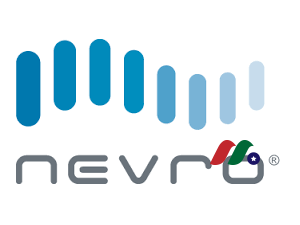
Nevro Corp.(NYSE:NVRO)创立于2006年,总部位于美国加州Redwood City,全职雇员308人,是一家医疗器械公司,主研脊髓刺激器。

Nevro Corp.(NVRO)美股百科
Nevro公司是一家医疗器械公司,在美国,欧洲和澳大利亚开发和商业化一个神经调节平台,用于治疗慢性疼痛。
Nevro提供Senza System,一个脊髓刺激系统(Spinal Cord Stimulator,SCS),提供其专有技术的HF10 Therapy——一种先进的SCS疗法,提供脊髓每秒10 kHz的电脉冲,相比于传统SCS,其可利用介于40 Hz至60 Hz之间较低的频率刺激,亦可缓解背部及腿部疼痛的感觉异常。电脉冲是将极小电极的发电机植入于接近脊髓的皮肤底下,其可充电电池拥有至少10年的电池寿命并符合CE标准。
Nevro Corp.通过其直销部门,以及销售代理和独立分销商网络销售其产品。
Nevro Corp.(NVRO)美股投资
- 参考资料:
| 行情 | =直达行情= | 评级 | =公司评级= |
| 百科 | =美股百科= | 机构 | =十大股东= |
| 官网 | =公司官网= | 分析 | =更多资讯= |
人人都能开户的0门槛美股券商 - 盈透证券(IBKR)
2025年,盈透证券(IBKR)支持中国人开户。盈透证券优势包括:1)不需要境外地址证明,人人都能开户;2)超强夜盘,支持24小时交易10,000+只标的;3)账户内闲置资金,自动获取4%利息收入;4)支持美债交易。
200股/1美元全包
点击查看详情
QQ群:249342519
加群验证:美股之家

249342519
微信号已复制
微信公号:美港股百科全书
微信搜:mggbkqs

mggbkqs
公众号已复制


1F
Proprietary JPM Survey #4: Street Estimates Continue to Look Conservative; Reiterate OW, PT to $112,2016/10/24:
The key takeaways from the survey are as follows: (1) Senza’s US launch continues to track well ahead of Street expectations – respondents forecast a 30% market share for Nevro in 2017, up from 22% in our April survey and what is 21% today amongst the respondents. Street consensus for Nevro’s 2017 share is 16.5%. (2) The number of physicians that have trialed Senza continues to grow and with it physician enthusiasm for the product. In our latest survey, 69% of respondents had implanted Senza, compared to 37% in April; amongst those that have implanted the device, 62% report better outcomes versus traditional tonic stimulation, compared to 50% in April; and amongst those that have experience implanting the device and have moved beyond trialing (52% of respondents) the projected 2017 share is 42.4% versus 14.5% amongst those that have yet to implant or are still in the process of trialing. All this points to (3) significant upside to 2017-18 consensus estimates on (a) an accelerating US market and (b) significant share gains for Nevro well above and beyond Street expectations.
Survey Details
Physician enthusiasm for Senza continues to build, as evidenced by our latest survey. In the survey, respondents expect Senza’s share of their overall mix to reach 21% in 2016 and 30% in 2017, up from 14% and 22% in our April survey (different respondents) and 12.0% and 16.5% in consensus models. We would characterize
both the 2016 and 2017 responses as in all likelihood above market (higher than what
investors should expect), reflecting the high level of exposure of our respondent base at this point in time to Senza – 69% have implanted, 52% have implanted and are now beyond the trialing phase, both of which are certainly above market rates.
Nonetheless, the enthusiasm for Senza and the high share and utilization expectations for 2016 and 2017 is certainly bullish for Nevro and a strong leading indicator of what investors can expect from the market overall in our view. Of note, in our survey 46 out of 50 docs said they expect to be implanting Senza in 2017, and considering the high degree of concentration in the SCS market where the top 5% or 220 accounts represent 30% of the procedure volume and the top 25% or 1,100 accounts do 75% of the volumes, we believe our 50 high-volume implanters are highly representative of market trends.
Even if one discounts the respondents’ 30% share projection for 2017 by 5%, the implication is 40% or $130M of upside to 2017 consensus estimates. If Senza expands the market faster than expected, estimates could be much higher. Even if it takes until 2018 for Nevro’s share to reach 25%, the implication would be $520M in 2018 sales versus current Street consensus of $415M. Assuming a 25% 2018 share puts NVRO’s valuation at 5.8x 2018 revenues versus the 7.3x implied by consensus.
In our survey, one theme that stands out is the impact of real world experience. A year ago when the US launch was just getting started, Nevro had the Senza RCT data to market (first head-to-head SCS trial and the first to demonstrate the superiority of one SCS system over another), but the vast majority of physicians were still skeptical: (1) because they weren’t used to seeing randomized trials in the space, and (2) the Senza RCT turned everything they thought they knew about spinal cord stimulation on its head. The key post-launch has been user experience. The RCT got physicians to trial it, but it’s each physician’s own real world experience that’s driven their share allocation to Senza significantly higher. A year ago competitors could counter detail HF-10 (Nevro’s high frequency, low amplitude stimulation), saying it doesn’t work and questioning the outcomes of the trial. A year later that sell is getting harder and harder to make as more and more clinicians implant the product and see for themselves that their patients are in fact doing better.
That’s why, if we fast forward a few months, if BSX tries to discredit high frequency therapy post an inconclusive or unsuccessful ACCELERATE trial, it’s going to fall on deaf ears. Too many surgeons and pain management specialists have implanted Senza already and seen for themselves that Nevro’s combination of anatomic lead placement and high frequency/low amplitude stimulation does result in better therapy. More patients respond, more convert from trial to permanent implants, and more report reduced pain scores/better outcomes. We’ll address ACCELERATE in greater detail in a subsequent note, but the short story is that based on all our clinical checks to date, the trial appears (1) to have been poorly executed (implant protocols were poorly defined and changed mid-trial) and (2) unlikely to show a benefit. HF-10 is superior to traditional tonic stimulation and it’s not just the frequency (10,000Hz vs 60Hz), but lead placement (at T8/T9 near anatomical midline vs. the traditional approach used through most of ACCELERATE of parasthesia mapping). Recall that BSX conceived and started ACCELERATE following Nevro’s successful launch in Australia and Europe but before the groundbreaking SENZA RCT was presented. Trial participants were asked to implant the older Precision neurostimulator in low back pain patients, perform parasthesia mapping to identify lead placement, and then following the implantation of the permanent implant, randomize half the patients to high frequency for 90 days. Instructions on lead placement changed over the course of the trial, but our read is that by trial end it was unable to show a benefit. We expect an update from BSX on ACCELERATE by year-end, but the implications for Nevro should ACCELERATE fail to demonstrate a benefit certainly aren’t negative and at this point there are simply too many docs that now know from their own experience that high frequency therapy with targeted lead placement is superior to tonic stimulation with parasthesia mapping.
Back to the survey. In our survey, 69% of respondents had implanted Senza, while another 22% had yet to implant, but were planning on it by the end of 2017. Amongst those that have implanted the device and have moved beyond trialing (52% of respondents) the projected 2017 share is 42.4% versus 14.5% amongst those that have to implant or are still in the process of trialing – the takeaway being that once clinicians trial in their own practices and see how well their patients are doing, their Senza utilization and share expectations move higher. With 42% of respondents in or entering the trial phase, we believe Senza share expectations will continue to move higher as more docs gain greater experience with the device.
Across the broader survey population, results were more favorable than our April survey now that more docs have experience with the device. 10% view Senza as their new workhorse (5% in Apr. survey), 16% see it as their go-to device for back pain (12% in Apr. survey), 24% as a 2nd line device in SCS failures (21% in Oct. survey), while 42% plan to or are currently testing it in a small group first (56% in Oct. survey). We view the shift from trialing Senza to using it as a 2nd line device as the natural progression, and expect Senza to garner more use as a front-line device as experience grows and some of the early reimbursement obstacles are overcome. 62% of the docs that have implanted Senza are already seeing better outcomes in Senza patients. As we’ve said in the past, over time we would expect that as physicians gain experience with Senza, they will not only see a greater decrease in pain, but also fewer patient complaints about paresthesia-induced pain, decreased efficacy, or not being able to drive. From our checks, this is a process that can take 3-6 months after implanting several patients. Patients typically see the implanting clinician 10 days, 1 month, 3 months, and 6 months post-implantation.
Compared to our last survey in April, initial reimbursement issues appear to be improving. As would be expected with new technology launches, especially one at a higher price compared to existing devices, managed care is applying some, but not substantial, pushback to incorporation into physicians’ practices: 32% of respondents that have implanted Senza cited no issues with reimbursement (vs. 14% in April), 50% have had occasional issues (vs. 43% in April), 12% experienced some early
challenges (vs. 29% in April), but report that the climate is better now, while just 6% now say that reimbursement is still challenging (vs. 14% in April).
If Nevro is gaining share, who is losing share? As we saw in our prior surveys, our sample size was over-indexed to Medtronic users (51%-55% share in this and the April survey vs. ~35% in reality in 2015). As such, Medtronic is hit the hardest in our survey with US share expected to decline from 41% in 2015 to 43% in 2016 and to 39% in 2017. Boston Scientific had 28% share in 2015 and is expected to lose 440bps and 360bps of share in ’16 and ’17, while St. Jude had 13% share in 2015 and is expected to lose 120bps and 100bps in ’16 and ’17 respectively.
Respondent enthusiasm for Burst appears mixed following the early October FDA approval, with just 12% of respondents expected to incorporate it into their practice. 78% might use it after several months depending how it fares, while 10% don’t anticipate using it. Just 30% of respondents view Burst as a differentiated technology, while 24% view it as undifferentiated and 46% are unsure. When asked to compare Burst vs. Tonic stimulation, 38% of respondents viewed Burst as superior while 34% viewed it as similar and another 24% needed head-to-head data before making a decision. Surprisingly, 50% of respondents viewed Burst as comparable to Senza, while 14% viewed it as superior. Of the 7 respondents who viewed it as superior, 3 haven’t yet implanted Senza and 5 are still trialing Senza. Further, these 7 respondents still forecast St. Jude to lose 100bps of share in 2016 and 2017 while Senza is forecasted to gain 600bps and 900bps over the same timeframe. In short, we don’t view Burst as a threat to Senza market share gains, but rather an interesting alternative to Tonic stimulation that should allow St. Jude to lose less market share than Medtronic and Boston Scientific.
For Nevro, as we outlined before, we continue to view Street estimates as notably conservative and see upside to 3Q ($58.2M), 4Q ($66.4M) and 2017 consensus ($319.9M). Assuming the US market grows 14-15% in 3Q as in 2Q, Street consensus implies a 12.3% US share, up just 70bps sequentially following 220bps of gains from 1Q to 2Q. While recognizing that we will see summer seasonality (more physicians on vacation, lower volumes, less initial trialing), that 12.3% implied by consensus certainly looks conservative to us. For 4Q, the Street’s $66.4M in revenues implies a 12.9% share, another 60bps of gains and again in our view conservative. As a reminder, every point of share adds $15-16M in 2017 revenues and with Street consensus today reflecting a 16.5% share, the implication of our now multiple surveys is a run-rate substantially higher. Finally, on the back of the survey, we reiterate our OW rating and see NVRO as our 2016 top small cap pick. We raise our price target from $100 to $112 (8.5x our conservative 2018 sales forecast discounted back by 1 year).